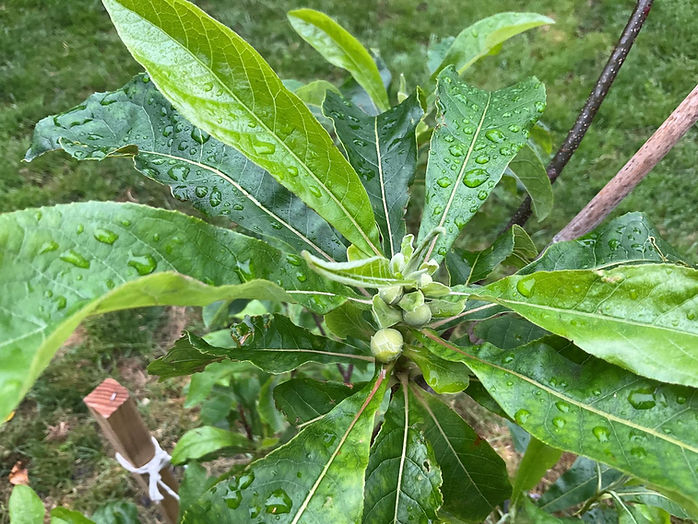Franklinia
Franklinia alatamaha
In March of 2025 the Friends of Matthias Baldwin Park purchased and planted four new species of trees in Baldwin Park. Two Franklinias were planted, one in the northeast corner and one in the northwest corner. The Franklinia is a medium-sized deciduous tree that has been extinct in the wild for the last 200 years. See Wikipedia entry here.
Franklinia has a special place in the hearts of Philadelphians because every Franklinia in the world comes from seeds that were once in Philadelphia. The trees were discovered by John and William Bartram of Philadelphia in 1765 on a two-acre plot of ground along the Altamaha River in coastal Georgia (Baldwin Park is two acres). Seeds were taken then and ten years later, and the trees were never to be seen in the wild again. To save your fingers a click, I will quote the Wikipedia page:
Philadelphia botanists John and William Bartram first observed the tree growing along the Altamaha River near Fort Barrington in the British colony of Georgia in October 1765. John Bartram recorded "several very curious shrubs" in his journal entry for October 1, 1765. William Bartram returned several times to the same location on the Altamaha during a collecting trip to the American South, funded by Dr. John Fothergill of London. William Bartram collected F. alatamaha seeds during this extended trip to the South from 1773 through 1776, a journey described in his book Bartram's Travels published in Philadelphia in 1791...It was not until after John's death (1777) that he was able to achieve flowering plants (1781). After several years of study, William Bartram assigned the "rare and elegant flowering shrub" to a new genus Franklinia, named in honor of his father's great friend Benjamin Franklin...
William Bartram was the first to report the extremely limited distribution of Franklinia. "We never saw it grow in any other place, nor have I ever since seen it growing wild, in all my travels, from Pennsylvania to Point Coupe, on the banks of the Mississippi, which must be allowed a very singular and unaccountable circumstance; at this place there are two or 3 acres (12,000 m2) of ground where it grows plentifully." After returning to Georgia after the American Revolution, Bartram was unable to find the trees...The tree was last verified in the wild in 1803 by the English plant collector John Lyon. The cause of its extinction in the wild is not known, but has been attributed to a number of causes including fire, flood, overcollection by plant collectors, and fungal disease introduced with the cultivation of cotton plants...All the Franklin trees known to exist today are descended from seed collected by William Bartram and propagated at Bartram's Garden in Philadelphia.


Franklinia in the northeast corner on left (top photo on a phone) and in the northwest corner on the right in March 2025 after planting.
Franklinia factoids:
-
the genus name honors Philadelphia's Ben Franklin
-
white flowers bloom in late July and resemble Camelia blossoms, as both are in the Theaceae family, which includes camelias and tea plants

A cluster of flower buds on the Franklinia in the northeast section in June of 2025.



